Napoleon Bonaparte as a factor in the epidemic process
The lull after the brilliant successes of the Italian campaign of 1796-1797 did not correspond to the political plans of General Bonaparte. After the first victories, Napoleon began to claim an independent role. He needed a series of victorious events that would strike the imagination of the nation and make him the favorite hero of the army.
He worked out a very adventurous expedition plan to capture Egypt in order to get in the way of England’s communications with India, and easily convinced the Directory (the government of the first French Republic under the constitution of the III year adopted by the National Convention in 1795) of the need for France to have a colony on the Red Sea from where the shortest way to reach India.
As you can see, the idea of "washing soldiers' boots with the waters of the Indian Ocean" came to mind Napoleon Karlovich a little earlier than Vladimir Volfovich ...
So, the Government of the Directory, fearing the popularity of Bonaparte, decided to get rid of its presence in Paris and put at its disposal the Italian army and navy.
The expeditionary army was assigned 24 thousand infantry with 4 thousand cavalry and 300 horses (the remaining horses were supposed to be purchased in Egypt), 16 companies of artillery, 8 companies of sappers, miners and workers, 4 park companies; total 32 people. The troops were 300 divisions.
To transport these troops, 309 vessels were prepared with a total displacement of 47 tons (300 in Marseille, 58 in Toulon, 72 in Genoa, 73 in Civita-Vecchia and 56 in Corsica).
Intended for escorting the expedition flotilla of 55 vessels (13 battleships, 6 frigates, 1 corvette, 9 flutes, 8 brig and messenger ships, 4 mortar ships and 12 gunboats and 2 feluks). Most of the troops stationed in Toulon and Marseille were to be deployed on military ships. The flotilla crew consisted of 10 thousand sailors. The expedition was attended by many scientists, researchers, engineers, technicians and artists (up to 100 people in total) in order to study the ancient country.
More information about this venture can be found at VO in very worthy and informative articles by Alexander Samsonov:
Battle of the pyramids. Egyptian campaign of Bonaparte.
Battle of the pyramids. Egyptian campaign Bonaparte. Part of 2.
Battle of the pyramids. Egyptian campaign Bonaparte. Part of 3.
I will focus only on a few key episodes of the events of those old days.
After the successful conquest of Egypt, Napoleon Bonaparte continued to attack the Ottoman territories in the Middle East.
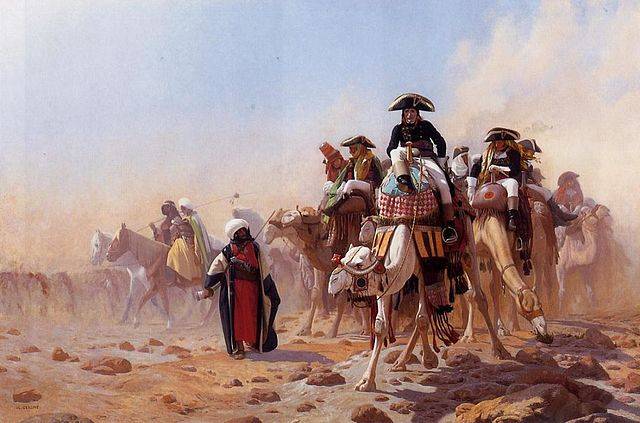
Literaryhistorical sources eloquently tell about these events:
4 thousand people were captured. Napoleon had neither supplies for their food, nor ships to send them by sea from Jaffa to Egypt, nor enough free troops to escort thousands of selected and strong soldiers through all the Egyptian deserts to Alexandria or Cairo. All prisoners were shot ...
In the houses, and on the streets, and on the roofs, and in the cellars, and in the gardens, and the gardens, the unsuitable corpses of the slaughtered population rotted, and on the shore there were thousands of prisoners. There is nothing surprising in the outbreak of the plague in the city ....
Immediately after this Bonaparte moved on to the fortress of Acre, or, as the French often call it, Saint-Jean d'Acre. The Turks called her Akka. There was no particular delay: the plague was on the heels of the French army. Staying in Jaffa was extremely dangerous.
The siege of Acre lasted exactly two months and ended in failure.
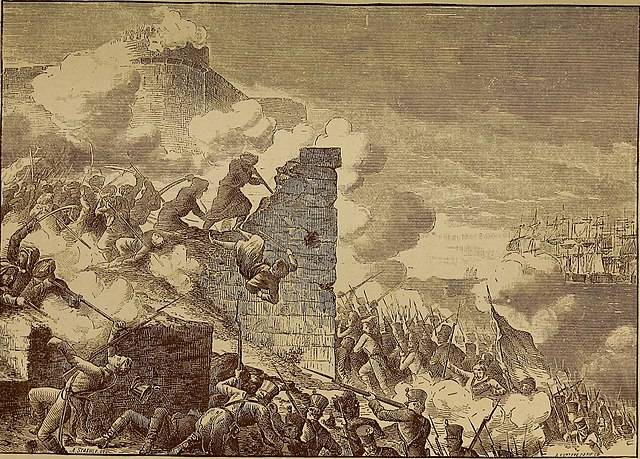
Bonaparte did not have siege artillery; the defense was led by the Englishman Sydney Smith; the British brought supplies from the sea and weaponThe Turkish garrison was great. After several failed attacks, May 20, 1799 had to lift the siege, during which the French lost 3 thousand people. True, the besieged lost even more. After that, the French went back to Egypt.
Meanwhile, in Ramla (about 20 km from Jaffa), where the French headquarters were located, a plague epidemic also broke out, literally mowing down the inhabitants of the city and the French troops.
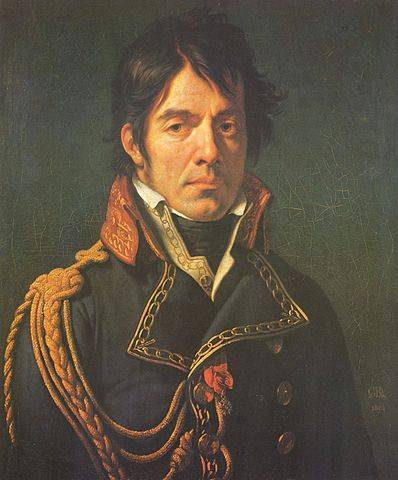
Dominic Jean Larrey (1766-1842) was a renowned practicing surgeon in Paris. In 1792 he was drafted into the army and sent to the Rhine, where there were then serious battles and the troops suffered heavy losses. Larrey became the chief surgeon of Napoleon's armies. From 1797 to 1815, he did a lot to improve the military-sanitary business - in particular, Larrey actively introduced modern methods of military field surgery in the army, and also significantly increased his mobility and improved the organization of field hospitals with his innovations. So, they were introduced "flying hospitals", ambulances, to provide operational assistance to the wounded. These were light, well-moving two-wheeled carts, each of which was harnessed by two horses. Following the advancing troops, they could quickly get to the battlefield, collect the wounded (this was done by specially trained assistant surgeons) and provide them with the necessary assistance in the field hospital.
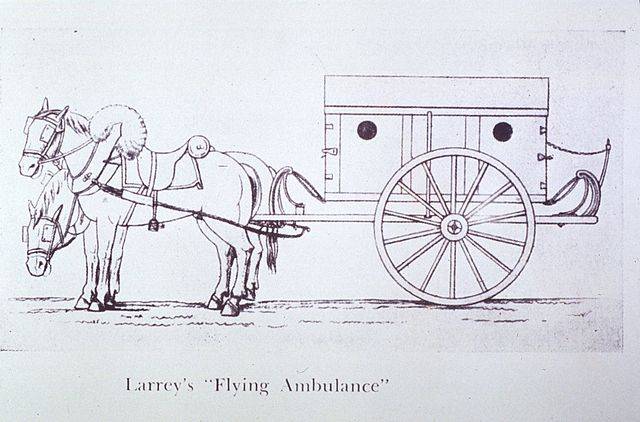
Looking ahead, I’ll say that already in 1793, at the Battle of Limburg (war of the First Coalition), Larrey’s “ambulances” proved to be excellent; many of the soldiers wounded in this battle were saved precisely because of the timely medical assistance provided. Soon, “flying ambulances” were organized throughout the French army, which markedly reduced irretrievable losses.
He introduced the practice of triage, that is, sorting the wounded according to the severity of the injuries received in battle. He also worked on improving sanitation, providing food to patients, and also trained medical personnel.
In 1799, at the battle of Abukir, he had, as contemporaries noted, to render assistance to almost two thousand wounded, and many operations (mainly amputations) were performed by him on the battlefield under enemy fire.
Among other innovations, he introduced into practice the use of lightweight bandages, pads and tampons made of thin cotton fabric. For this purpose, he used fabric, which in those days was called the "Gaza fabric." Since the Middle Ages, it was produced by Jewish weavers in the Gaza region. In fact, this fabric in a very starched form was transported to Europe for a long time, where it was used for lining fluffy skirts. Until that time, dense and rigid clothes were used for dressings. No one made special dressings. Larrey first saw her in a natural soft form. Today we know this fabric as gauze.
Larrey provided the necessary assistance to the wounded soldiers of the enemy. A case was described when, during a trip to Russia, upon entering the city of Vitebsk, 350 Russians were found abandoned in solitude and dirt, unable to move: they were all gathered, dressed, transferred to a hospital, where they received the same help as the French.
In 1812, during the battle of Borodino, he spent 200 amputations, spending an average of 7,2 minutes for each, about which he recalled:
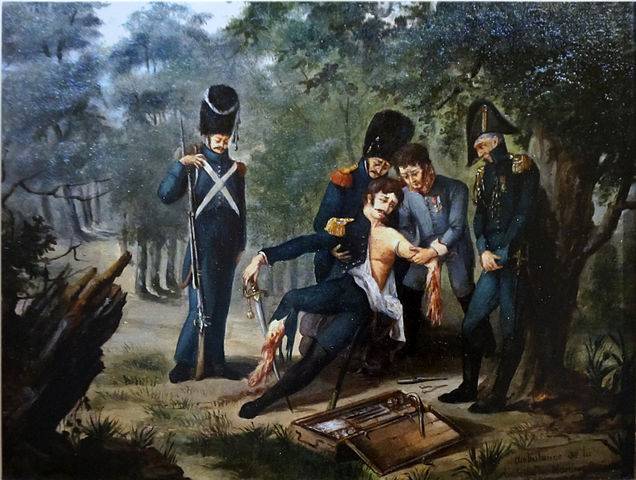
Larrey amputates Colonel Rebsomen's arm and leg in Hanau
During the Battle of Waterloo, the courage of Larrey, personally participating in helping the wounded under fire, was noticed by the Duke of Wellington, who at one point in the battle ordered his soldiers to cease fire in his direction, giving Larrey the opportunity to collect the wounded.
Larrey was captured by the troops of Prussia and was initially sentenced to death, but was pardoned and sent under escort to France.
For his services, Larrey was awarded the Legion of Honor three times.
On June 14, 1799, Bonaparte's army returned to Cairo.
He transferred the high command of the army to General Kleber, ordered to hastily and rigorously equip four vessels, put about 500 people selected by them on them and sailed to France on August 23, 1799.
The plague remained on the shores of the Mediterranean Sea. Napoleon left the Levant, leaving her with a nose. However, that was not all ...
Napoleon’s troops who returned from the Egyptian campaign brought to France and then spread epidemics of eye diseases throughout Europe: trachoma, which was joined by bacterial purulent conjunctivitis. The disease was called "Egyptian inflammation." These were the first epidemics of eye diseases in Europe. There was no cure for an unknown infection at that time. The disease led to the defeat of not only the conjunctiva, but also the cornea. The infection through the cornea inside the eye ended in blindness and even death of the eye. Moreover, it was a rather insidious disease: even once cured, a person was not protected from reinfection, since the body did not develop immunity to infection. But the worst thing in this disease is the speed of its spread. The source that arose in one place in a short time covered the masses, and such outbreaks constantly occurred.
Thus, trachoma appeared first among the military, and then among the civilian population. In 1801, the disease was discovered on the island of Malta and in Genoa, in 1802 in England, in 1813 in Germany.
At this stage, Karl-Ferdinand Grefe (1787-1840) joined in the fight against trachoma. At one time, he was the personal physician of the Duke Alexius of Anhalt-Bernburg.
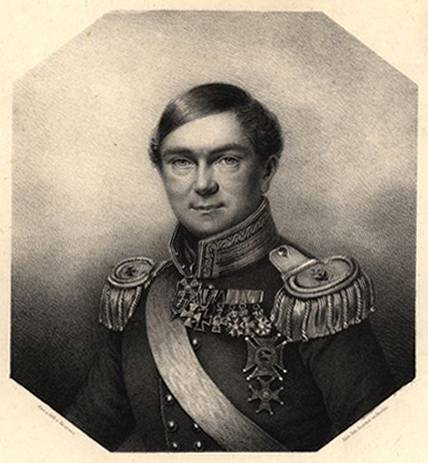
In 1811, at the age of 24, Karl-Ferdinand was awarded the title of Ordinary Professor of Surgery and Eye Diseases. He was the director of the eye clinic at the University of Berlin and became one of the founders of German ophthalmology.
In 1813, during the sixth coalition of European powers against Napoleonic France, he was appointed head of military hospitals with the rank of General Staff Doctor of the Prussian Army, where, among other things, he rendered ophthalmological assistance to soldiers suffering from "Egyptian eye inflammation."
For merits and courage in the treatment of soldiers of the Union Army, the Russian Emperor Nicholas I granted Karl Gref in 1826 the noble title and inheritance right to the prefix "background". Thus, the German family Gref became Russian nobles. His son, Albrecht von Graefe, will also become an ophthalmologist, and with a worldwide reputation, he will do a lot in the future for the development of ophthalmology in Russia.
In 1817-18, an epidemic erupted among the Russian troops occupying France, and was brought by them to Russia. First trachoma spread in the Kingdom of Poland (1818-1820).
In St. Petersburg, the first cases were noted in 1832.
The initial epidemics caused a lot of diseases and were terrible in their consequences. In the English army in 1818 there were 5000 disabled people who were blinded by this disease, in the Russian army in the 20s and 30s, about 80 people fell ill, in Belgium in 000 every fifth soldier suffered from trachoma, the number of people who were completely blind or partially lost their eyesight, in the tens of thousands.
In 1823, Ivan Petrovich Butkov (1782-1856), doctor of medicine and senior doctor of the Guards Infantry, was ordered to take measures to end the epidemic raging in Crimea among the soldiers of the Russian Imperial Army. He studied in detail the causes of the spread of the disease, improved the sanitary condition of the troops and managed to stop the epidemic. For this, he was rewarded, among other signs of the highest mercy, with the Order of St. Anna of the 2nd degree with diamonds, the Order of St. Vladimir of the 3rd degree and an all-merciful gift. Butkov described his observations on the epidemic in a scientific paper, "A Brief Description of Eye Inflammation Appearing in the Crimea in the Troops Participating in the Turkish Campaign of 1824."
At the end of the XNUMXth century, an epidemic of trachoma swept the Kazan province and the Volga region. In conditions of low hygiene, trachoma infected hundreds of thousands of people, mainly representatives of the poor. Tatar villages of pre-revolutionary Russia were completely covered by an epidemic.
November 14, 1922 in Kazan was founded the first in Russia scientific medical institution to combat trachoma.
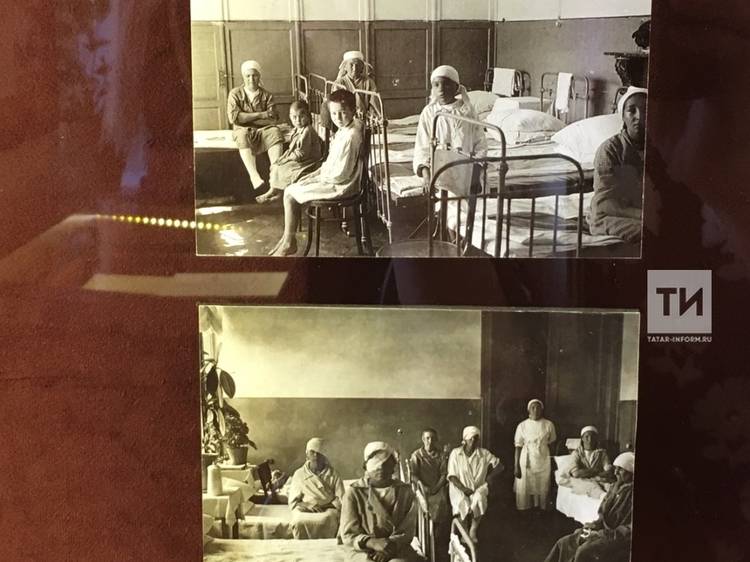
Wards for trachoma patients (1930s)
Trachoma began to recede only in the postwar years. Effective methods of treating this disease were found, measures were taken to alert the population, informational work, and discussions were organized among schoolchildren. Effective chemicals were used - albucides, later tetracycline and other antibiotics will appear. In 1964, a complete victory over the trachoma was declared on the territory of the TASSR.
Sources:
Napoleon. Selected works. M .: Military Publishing House, 1956
Tarle E.V. Napoleon. ZHZL. 1936.
Articles from the Brockhaus and Efron Encyclopedic Dictionary.
Wikipedia et al.
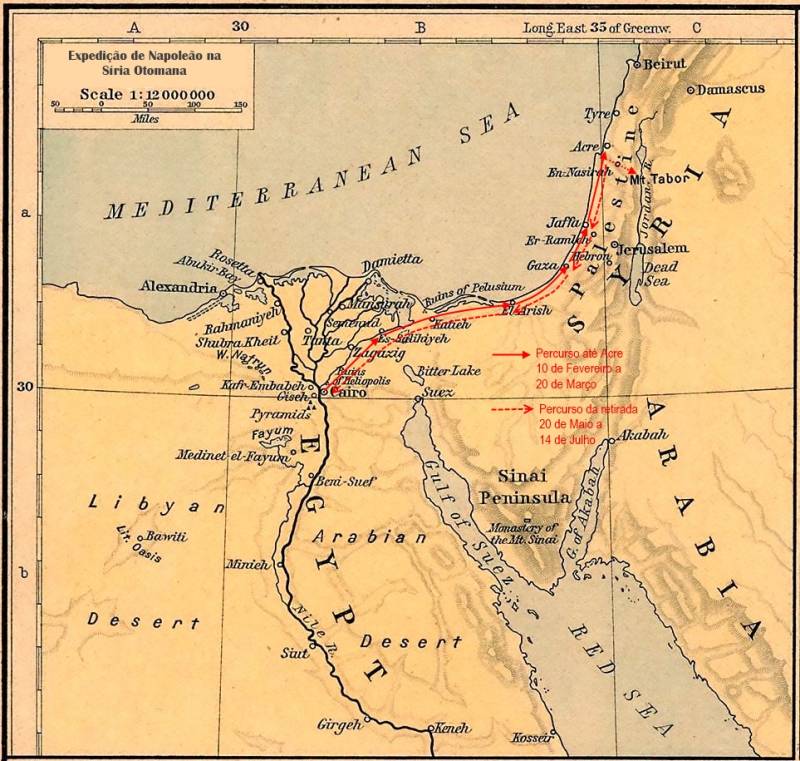
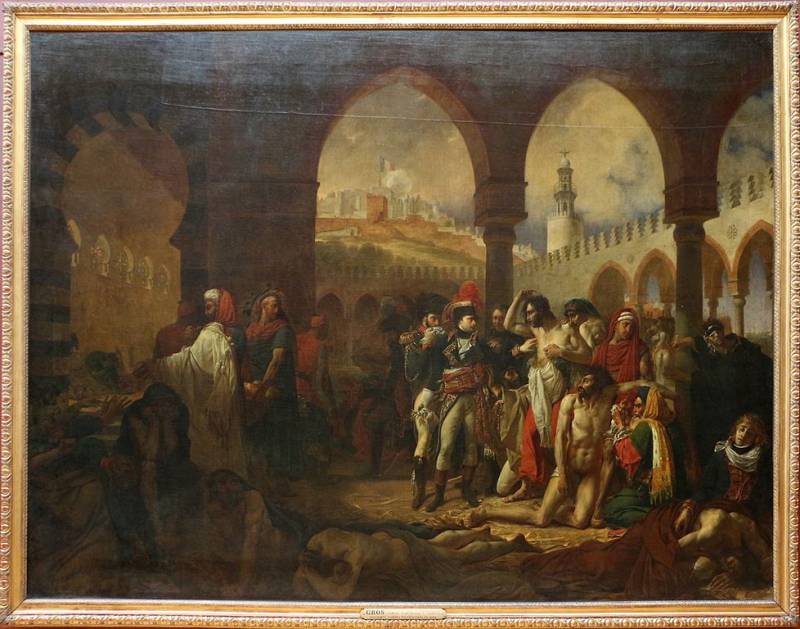
Information